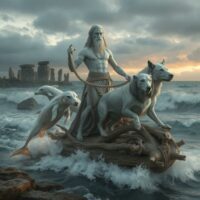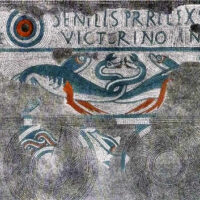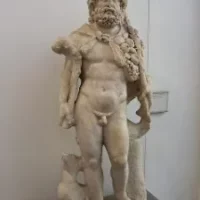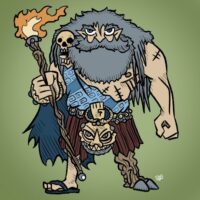Nodens : God of the Sea
Listen
At a glance
| Description | |
|---|---|
| Origin | Celtic Mythology |
| Classification | Gods |
| Family Members | N/A |
| Region | Britain |
| Associated With | Hunting, Healing, Sea |
Nodens
Introduction
Nodens, a deity from ancient British and Celtic mythology, holds a unique place among the pantheon of pre-Roman and Romano-British gods. Known under various spellings such as Nodons, Nudens, or Nudd, this enigmatic figure was deeply revered in western Britain during the Roman occupation. The most significant evidence of his worship comes from Lydney Park in Gloucestershire, where a grand temple complex once stood, surrounded by offerings and inscriptions that offer tantalizing glimpses into his divine persona. Blending native Celtic traditions with Roman interpretations, Nodens was a god of healing, the sea, hunting, and dreams—realms that collectively symbolized both survival and spiritual guidance for ancient peoples. His connections to deities in Welsh and Irish mythology reveal a broader cultural resonance that spanned regions and languages.
Physical Traits
Although no definitive visual representation of Nodens has survived, the artefacts and symbols discovered at his temple provide a strong sense of how his followers perceived him. Figurines of dogs—nine in total, one even bearing a human-like face—suggest that these animals were sacred to him, likely symbolizing healing, loyalty, and possibly shapeshifting abilities. Another significant discovery was a bronze arm with unusually shaped fingernails, possibly referencing a divine limb used for healing, or symbolically representing a miraculous restoration of physical form. Reliefs found at the site depict a deity in a sea-chariot drawn by hippocamps and surrounded by marine figures like dolphins and tritons, reinforcing his dominion over water and the mystical world beneath. These rich symbols point to a divine figure who was as much a master of physical well-being as he was of the dreamlike realms of the sea and spirit.
Family
Though direct genealogical records are absent, Nodens’ familial affiliations are better understood through mythological analogs. In Welsh mythology, he corresponds to Nudd, the father of Gwyn ap Nudd, who rules the Otherworld known as Annwn. This positions Nodens as a progenitor of underworld deities and associates him with the mysteries of death, rebirth, and the beyond. Irish mythology offers a parallel in the form of Nuada Airgetlám, the “Silver-Handed” leader of the Tuatha Dé Danann, known for both his kingship and his healing capabilities. The Welsh figure Lludd Llaw Ereint, another silver-handed character, echoes these attributes and likely shares roots with Nodens. These connections suggest that Nodens was part of an ancient and prestigious divine lineage, one that blended royal authority with mystical and medical power.
Other names
The various names and titles attributed to Nodens reflect both linguistic diversity and his broad range of functions. Known regionally as Nodons, Nudens, Nudd, or Lludd, his identity evolved through oral traditions, regional dialects, and Roman influence. Some epithets hint at his divine responsibilities—titles like “Lord of the Waters” and “He Who Bestows Wealth” suggest a benevolent provider with control over both natural elements and fortune. The name “God of the Abyss” could reference his connection to the sea or the underworld, realms often linked in Celtic cosmology. The Roman designation “Mars Nodens” aligns him with the god of war in a healing context, revealing the syncretic approach of Roman Britain in interpreting native deities through familiar Roman archetypes. These varying names capture different facets of Nodens’ character—from ruler and protector to healer and dream-bringer.
Powers and Abilities
Nodens possessed an expansive set of abilities, with his most prominent role being that of a healer. Excavations at Lydney Park revealed votive offerings of body parts and inscriptions requesting cures, making it clear that people sought his aid for physical ailments. His sacred dogs, associated in ancient Celtic tradition with healing and guidance, underscore this function. Beyond the corporeal, Nodens was deeply tied to dreams and prophecy. Scholars suggest that his temple may have served as an incubatio site, where worshippers would sleep in hopes of receiving divine visions or answers from the god himself. His marine symbolism—chariots drawn by hippocamps, depictions of dolphins and fish—places him firmly in the domain of water, linking him to the subconscious and spiritual depths. Additionally, his associations with mist and vision suggest powers related to concealment and divine perception. Some speculative interpretations even propose that Nodens had shapeshifting capabilities, adding another layer to his already complex divine role.
Modern Day Influence
Despite the passage of centuries, Nodens continues to exert influence in modern culture and spirituality. His name and mythology have been revived in contemporary neopagan and Celtic reconstructionist circles, where he is venerated as part of efforts to restore pre-Christian belief systems. Lydney Park, where his temple once stood, remains a vital archaeological site and a place of historical reflection for scholars and spiritual seekers alike. In literature, Nodens captured the imagination of J.R.R. Tolkien, who studied the inscriptions at Lydney and later drew inspiration from them while creating elements of his Middle-earth mythology, notably the character Celebrimbor—whose name, meaning “Silver-Hand,” nods to Nodens’ mythological counterparts. The god also appears in the fictional universe of H.P. Lovecraft, who transformed him into a cosmic entity known as the “Lord of the Great Abyss.” In this reinterpretation, Nodens is a benevolent Elder God who commands night-gaunts and serves as a counterforce to the chaotic Nyarlathotep, illustrating his continued adaptability in the realms of fantasy and horror.
In contemporary pop culture, Nodens has been featured in role-playing games, graphic novels, and even anime, typically portrayed as a mystical, often otherworldly being with immense power. His mythic profile—healer, dream-giver, sea-god—resonates with themes of transformation, inner vision, and spiritual depth, making him a compelling figure for modern storytelling and media. Whether as an ancient god invoked at sacred springs or a cosmic protector in speculative fiction, Nodens remains a vivid and enduring symbol of the mysterious interplay between healing, dreams, and the unknown.
Related Images
Source
“Nodens – Wikipedia.” (n.d.). Retrieved from https://en.wikipedia.org/wiki/Nodens
“Nodons in Britain and Ireland.” (1984). https://www.semanticscholar.org/paper/a1e7ee45837dec1b56f6a8c53cba596d93c21064
Abrams, C. (2011). Myths of the Pagan North: The Gods of the Norsemen. https://www.semanticscholar.org/paper/6d7b45203162406e4e983db18b4e64d87ac9540e
“Nodens: healing god | We Are Star Stuff.” (2018, July 5). https://earthandstarryheaven.com/2018/07/05/nodens/
“Nodens – Dun Brython.” (n.d.) http://www.dunbrython.org/nodens.html
“Nodens: Facts for Kids.” (2025, June 13). https://kids.kiddle.co/Nodens
“Nodens – Explore Mythology – Gods and Monsters.” (n.d.). https://godsandmonsters.info/nodens/
“Nodens | Myth and Folklore Wiki – Fandom.” (n.d.). https://mythus.fandom.com/wiki/Nodens
“Nodens – Celtic God of Healing – Symbol Sage.” (n.d.). https://symbolsage.com/nodens-celtic-healing-god/
Frequently Asked Questions
What is lorem Ipsum?
I am text block. Click edit button to change this text. Lorem ipsum dolor sit amet, consectetur adipiscing elit. Ut elit tellus, luctus nec ullamcorper mattis, pulvinar dapibus leo.
What is lorem Ipsum?
I am text block. Click edit button to change this text. Lorem ipsum dolor sit amet, consectetur adipiscing elit. Ut elit tellus, luctus nec ullamcorper mattis, pulvinar dapibus leo.
What is lorem Ipsum?
I am text block. Click edit button to change this text. Lorem ipsum dolor sit amet, consectetur adipiscing elit. Ut elit tellus, luctus nec ullamcorper mattis, pulvinar dapibus leo.
What is lorem Ipsum?
I am text block. Click edit button to change this text. Lorem ipsum dolor sit amet, consectetur adipiscing elit. Ut elit tellus, luctus nec ullamcorper mattis, pulvinar dapibus leo.
What is lorem Ipsum?
I am text block. Click edit button to change this text. Lorem ipsum dolor sit amet, consectetur adipiscing elit. Ut elit tellus, luctus nec ullamcorper mattis, pulvinar dapibus leo.










